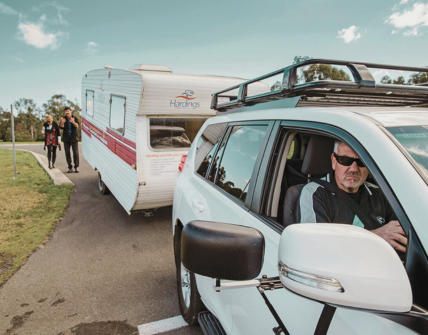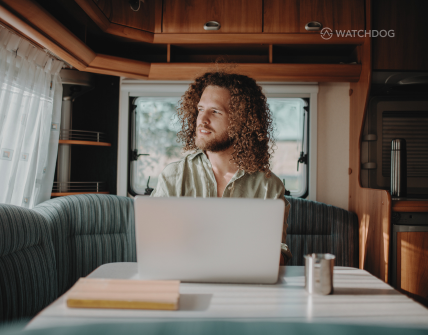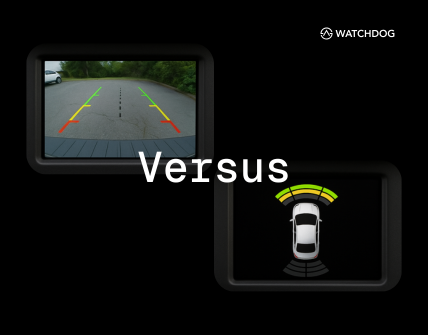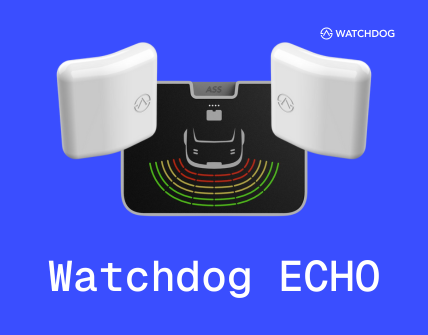
You don’t forget the first time a four-ton caravan vanishes in your blind spot. One second, it’s framed in your mirrors; the next, it’s somewhere in the ether while your palms go slick and your neck cranes for an angle that doesn’t exist. The French have a phrase for the zones you can’t see: angles morts, the dead angles now plastered on so many trucks. We kept seeing those yellow “ANGLES MORTS” stickers on European roads and wondered why a modern driver still has to white-knuckle through invisible space. Surely there had to be a better way than guessing.
We’re R.R. and L.P.—a chemist-inventor and a business-ops tinkerer—both outdoors people, gadget geeks, and longtime caravaners. In 2023 we registered our company, Autonomous Safety Systems JSC, and created the Watchdog brand with one stubborn idea: drivers deserve the comfort of blind-spot-free movement, without effort. That’s the whole mission distilled to a sentence, and it hasn’t changed since day one.
It Started at the Campsite
The spark wasn’t glamorous. It was campsite-level frustration. We kept noticing that most caravans and motorhomes we met—especially older models—had no parking aid at all. Tow a caravan and the challenge gets weirdly harder: even if your car has sensors, the moment a trailer plugs in, the connection is fragile or simply nonexistent. No link, no help; you’re back to craning over your shoulder, hoping. That’s when R.R. started sketching a universal solution – if the caravan can’t “talk” to the car, let the caravan talk directly to the driver.
Around the same time, we were doom-scrolling accident data. It’s sobering: backing up and maneuvering together account for roughly a fifth of crashes; that’s a lot of bent metal and shaken people caused by seconds of zero visibility and a pinch of overconfidence. The root problem isn’t just bad habits—it’s a broken connection between the vehicle and whatever it tows. And the industry answer—“full automation is coming”—kept drifting further right on the timeline. We didn’t want to wait ten years for a luxury feature when a practical one could save a weekend, or a life, right now.

The Space We Couldn’t See
The villain of our story isn’t a person. It’s the blind spot, multiplied by cables, plugs, and compatibility headaches. Add in the human factor—people make more errors than machines—and it gets clearer why incidents happen. A UK statutory review of trailer safety showed five times more collisions linked to people-related factors than to vehicle faults; the top defect culprits, when they do show up, are plain: tyres, lights, brakes, hitching. None of that negates what better awareness can do—it reinforces it. If humans slip, give humans better solution, earlier.
Roadside reality backs that up. When the DVSA stopped light trailers (O2 category) across Great Britain, half were non-compliant, and 29% were in such poor shape they got immediate prohibitions. Heavier, regulated trailers fared better. Translation: people are using lots of small trailers in imperfect condition, and they’re using them in traffic. That’s when watchfulness matters most.
When the Trailer Learned to Speak
Our lightbulb moment was deceptively simple: make the trailer smart on its own terms, then talk to the driver the way everything else in life does—wirelessly. No bespoke loom. No surgery on a car’s electronics. No special head unit. The trailer should sense, think, and warn—autonomously—and the driver should see and hear it on what they already use, from a dedicated device to a phone or in-car multimedia app. In other words: universal, wireless, and effortless.
We also dug into what actually helps: rear ultrasonics can cut backing accidents by about 62%, and pairing sensors with a camera pushes the impact toward 74%. These aren’t sci-fi promises; they’re the quiet, incremental tech that keeps people out of trouble. Now put them on the trailer, where the risk is, and you start to erase the dead angles that sticker only warns about.
From Sketches to Gravel Roads
Early on, we drew two hard lines:
- No tools required beyond what you already own.
- No distance limits that break when the rig gets long.
That set our priorities. Hardware had to be rugged, sealed, and easy to attach. Wireless had to be rock-solid through rain, dust, vibration—and yes, through the sheer length of a tractor-trailer or a car-caravan combination. Power needed to be self-sufficient. And the whole thing had to set up in minutes, not an afternoon with a wiring diagram. That’s not because users aren’t clever—most are very capable. It’s because they should spend their time doing what they actually love.
We built and broke prototypes. We tested with friends in road freight and fellow caravaners. We learned the hard way that “plug-and-play” is a promise you only make after you’ve fought with real-world situations.

A Quiet Reverse
Our first win wasn’t a press release. It was a calm reverse into a tight, blind corner—no shouting outside, no hand waves, no guesswork, no crunch. The moment test trailer drivers saw live distance cues and heard the graded alerts, muscle tension dropped. Confidence came back. That’s when we knew we weren’t building a gadget; we were restoring composure—the kind drivers keep after decades behind the wheel, and the kind newer drivers haven’t had time to earn.
Why it matters beyond us
Watchdog is a brand, but the point is people. In EU and UK policy circles, the talk is about halving road casualties by the 2030s. That’s a noble, necessary target—and it’s a long road. In the same UK review, the government didn’t move to blanket-test all light trailers; the economics weren’t convincing.
And then there’s the base reality: trailers of all kinds are everywhere. General-purpose trailers, caravans, plant and vehicle transporters—they mingle with commuters and cyclists on the same streets. When DVSA pulled data from random roadside checks, compliance tracked with age and maintenance: newer gear, better outcomes; neglected gear, worse. That’s life. We can’t control who services what, but we can blunt the consequences of the next missed mirror check or fogged camera with a system that always sees.
Zoom out to freight and you see the same pattern. Heavy trailers are already regulated and tested; light ones aren’t. People still overload, mis-hitch, or tow with under-inflated tyres. In 2017 data, just 20 injury collisions in Great Britain were assigned a vehicle defect that a test might have caught—but hundreds involved people factors. That’s precisely the space for practical driver aids: where humans will be human and a timely cue turns a near-miss into nothing at all.
The vision
Our vision is straightforward: make people forget they ever had a blind-spot problem. Not because risk disappeared, but because the tool faded into the background and quietly did its job. The way good safety tech should. We talk about it internally like this:
- Mission: give drivers the comfort of blind-spot-free movement with no effort.
- Vision: an effortless, universal layer of autonomous trailer safety.
- Strategy: deliver absolute comfort by making installation simple, use effortless, connectivity completely wireless, and operating distance effectively unlimited—so users decide when, where, and how they use it.
We keep the audience wide on purpose: hobbyists, owners, pros, fleets. There’s no reason safety should be a premium feature on a premium rig. And yes, we’re building for the next generation too. Call it realism: Gen Z drivers grew up with better UX and fewer wrenches. The way to set them up for success isn’t a lecture—it’s giving them tools that work like the rest of their life does: on a phone, paired in seconds, clear at a glance. Customers literally ask, “why isn’t this just on my phone?” We take that as a requirement, not a comment.
The product principles we won’t compromise on
We’ve burned these into our roadmap because the field demands it:
- Universal fit: from tiny utility trailers to long combinations, it has to work without custom loom installs.
- Zero-drama setup: if you can mount a bike light and pair Bluetooth, you can deploy Watchdog.
- Autonomous sensing: sensors and logic live on the trailer, where they belong.
- Driver-first interface: glanceable visuals, graded audio cues, and minimal false alarms.
Are we allergic to cables? Not exactly. We’re allergic to the ones that stop drivers from adopting safety. When people try to install what’s sold today and give up, that’s not a user problem. It’s a product problem. We’re here to fix it.
The world we’re walking into
Some will say the market’s saturated. We disagree. There’s no strong, driver-obsessed brand owning trailer safety end-to-end. There’s a giant, existing user base—our internal estimate is hundreds of millions worldwide—wrestling with the same old blind spots. Policy is inching forward. Technology is ready. But the link between the trailer and the driver experience? That’s the missing piece. If it isn’t us, it will be someone. The gap is obvious. We plan to close it.
What We Refuse to Be
We’re not waiting for Level-everything autonomy to trickle down. We’re not another “camera-only” widget that fogs at the worst moment. And we’re not going to pretend regulation alone will fix behaviour. Even the UK’s statutory report concluded that imposing testing and registration on light trailers wasn’t clearly justified—meanwhile the user behaviour campaigns rolled on. We fit with that reality: practical help, now, in the hands that need it.
What comes next
You’ll see us roll out across segments in waves: the weekenders first (because that’s where the pain is loudest), then owner-operators, then fleets. You’ll see a design language that doesn’t look like “safety gear”—it looks like something you’re happy to use. And you’ll see us obsess over the boring details—vibration, mounts, rain ingress—because boring details are where confidence comes from.
If you care about the macro picture, there’s room for optimism. Regulators and researchers are exploring how to fold trailers into the broader push for safer, cleaner road transport; they want better transparency on trailer tech and adoption. We’re here for that conversation, and we’ll keep our findings public-minded. Safer trailers make safer streets, and safer streets belong to everyone.



